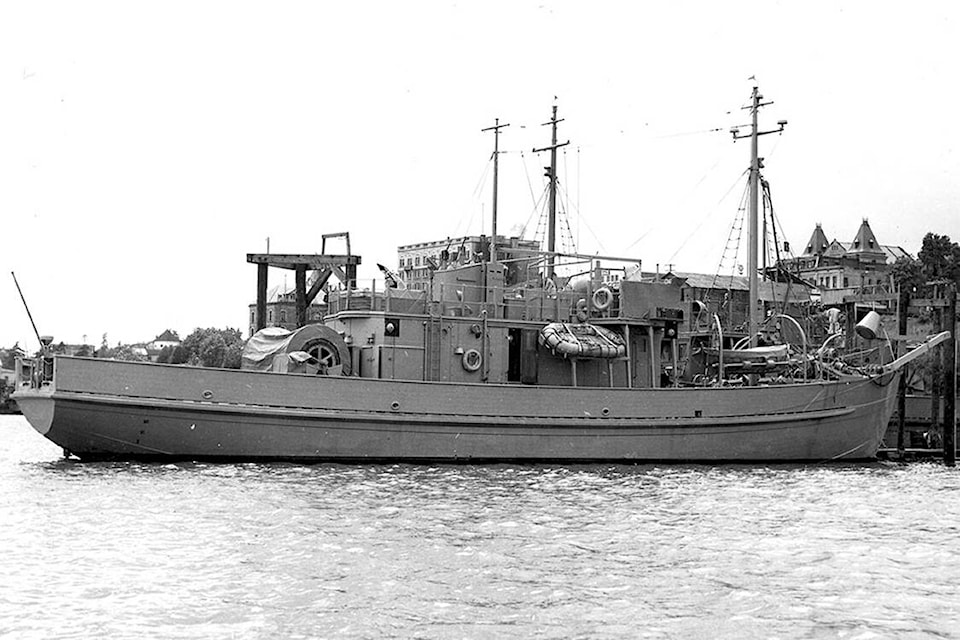Nanaimo contributed more than soldiers and training bases during the Second World War.
The city, or at least a shipbuilder located here, was pressed into building minesweepers and patrol boats for the war effort.
Newcastle Shipbuilding Company was commissioned in the 1940s to build Llewellyn-class and Lake-class minesweepers for the Royal Canadian Navy and patrol and supply vessels for the Royal Canadian Air Force.
Llewellyn-class minesweepers were wooden-hull ships ordered after the German navy deployed magnetic-influence sea mines at the start of the war, triggered by an approaching ship’s magnetic field. Wooden ship hulls, compared to ships with steel hulls, generated much weaker magnetic fields in seawater and so had a much lower chance of causing the mines they were sweeping to accidentally detonate close to them.
According to an article written by Fraser M. McKee for the July 1989 issue of the Canadian Nautical Research Society newsletter, Argonauta ships were desperately needed for the Battle of the Atlantic and Canadian shipbuilding facilities of all kinds were pressed into service, including the Newcastle Shipbuilding Company, which specialized in building wooden vessels.
Llewellyn-class minesweepers were 105-foot craft based on an existing design. Of 286 Llewellyn minesweepers built during the war, 33 were constructed in Canada and six in Newfoundland, which had yet to join confederation. Eight that were ordered for the Royal Canadian Navy were built in B.C. and Quebec.
Minesweepers HMCS St. Joseph, named for St. Joseph de Grantham, Que., and HMCS Coquitlam were built at Newcastle Shipbuilding Company, located near the mouth of the Millstone River, according to an article by John M. MacFarlane, Vessels Built by the Newcastle Ship Building Co., published in the Nauticapedia virtual maritime museum. Both ships were commissioned in 1944. HMCS St. Joseph’s construction required 105,000 feet of Douglas fir that was processed in local sawmills, according to a Nanaimo historian Jan Peterson’s Harbour City: Nanaimo in Transition 1920-1967.
HMCS St. Joseph spent its wartime service in Esquimalt and Prince Rupert and was sold to Mexican owners in 1947. HMCS Coquitlam also served on the West Coast, but after the war was sold to the Anticosti Shipping Company, rechristened MV Wilcox, and was abandoned in the Gulf of St. Lawrence after it was run aground on Anticosti Island in 1954, according to Government of Canada information.
Newcastle Shipbuilding also constructed three 120-foot Lake-class minesweepers, two of which were sent for service in the U.S.S.R., a number of supply boats, several which went into service with the Royal Canadian Air Force, four patrol boats and at least two tugs.
Post-war, the company built work boats and tug boats until the late 1940s, according to information from MacFarlane’s article, but details about the shipyard from different sources vary.
Shipbuilding History, a website created to compile construction records of Canadian and U.S. shipbuilders and boatbuilders, lists Newcastle Shipbuilding as a “true ‘emergency’ yard only in operation from 1943 through 1947.” The Nauticapedia credits the company with having built three three-masted schooners – Ehrenfels, Enterprise (XVII) and St. George in 1882 – and the Edward L. Doheny, a U.S.-registered tanker in 1913.
Both sites agree that the Nanaimo shipbuilder constructed minesweepers HMCS St. Joseph, HMCS Coquitlam, both completed in 1944 as well as the RCAF supply boats Hequiat and Kimsquit, patrol boats FD 1, FD 2, and FD 3 and the tug D.H. McDougall, all completed in 1944, minesweeper HMCS Willow Lake in 1946, and the fishing vessel Storm III in 1947.
READ ALSO: Unmarked Grave Program looking for Canada’s lost veterans
photos@nanaimobulletin.com
Like us on Facebook and follow us on Twitter
